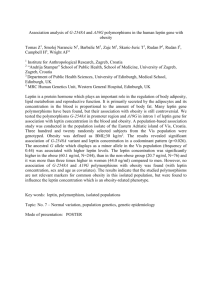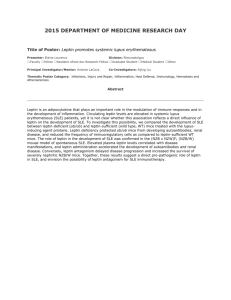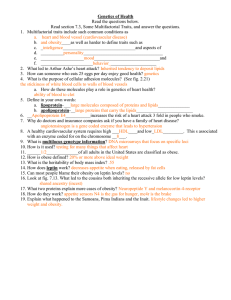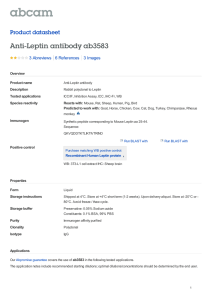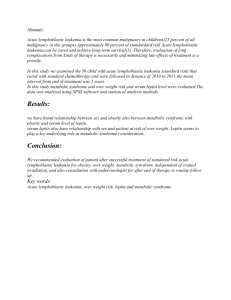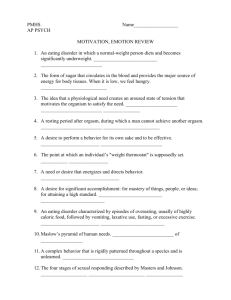advertisement
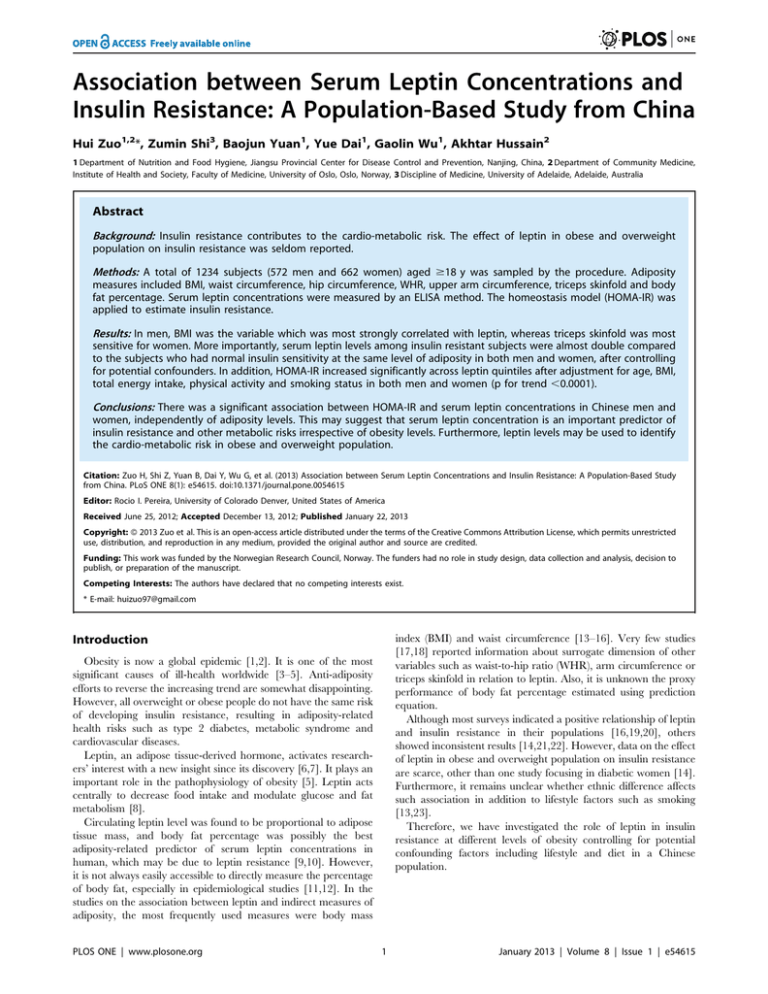
Association between Serum Leptin Concentrations and Insulin Resistance: A Population-Based Study from China Hui Zuo1,2*, Zumin Shi3, Baojun Yuan1, Yue Dai1, Gaolin Wu1, Akhtar Hussain2 1 Department of Nutrition and Food Hygiene, Jiangsu Provincial Center for Disease Control and Prevention, Nanjing, China, 2 Department of Community Medicine, Institute of Health and Society, Faculty of Medicine, University of Oslo, Oslo, Norway, 3 Discipline of Medicine, University of Adelaide, Adelaide, Australia Abstract Background: Insulin resistance contributes to the cardio-metabolic risk. The effect of leptin in obese and overweight population on insulin resistance was seldom reported. Methods: A total of 1234 subjects (572 men and 662 women) aged $18 y was sampled by the procedure. Adiposity measures included BMI, waist circumference, hip circumference, WHR, upper arm circumference, triceps skinfold and body fat percentage. Serum leptin concentrations were measured by an ELISA method. The homeostasis model (HOMA-IR) was applied to estimate insulin resistance. Results: In men, BMI was the variable which was most strongly correlated with leptin, whereas triceps skinfold was most sensitive for women. More importantly, serum leptin levels among insulin resistant subjects were almost double compared to the subjects who had normal insulin sensitivity at the same level of adiposity in both men and women, after controlling for potential confounders. In addition, HOMA-IR increased significantly across leptin quintiles after adjustment for age, BMI, total energy intake, physical activity and smoking status in both men and women (p for trend ,0.0001). Conclusions: There was a significant association between HOMA-IR and serum leptin concentrations in Chinese men and women, independently of adiposity levels. This may suggest that serum leptin concentration is an important predictor of insulin resistance and other metabolic risks irrespective of obesity levels. Furthermore, leptin levels may be used to identify the cardio-metabolic risk in obese and overweight population. Citation: Zuo H, Shi Z, Yuan B, Dai Y, Wu G, et al. (2013) Association between Serum Leptin Concentrations and Insulin Resistance: A Population-Based Study from China. PLoS ONE 8(1): e54615. doi:10.1371/journal.pone.0054615 Editor: Rocio I. Pereira, University of Colorado Denver, United States of America Received June 25, 2012; Accepted December 13, 2012; Published January 22, 2013 Copyright: ß 2013 Zuo et al. This is an open-access article distributed under the terms of the Creative Commons Attribution License, which permits unrestricted use, distribution, and reproduction in any medium, provided the original author and source are credited. Funding: This work was funded by the Norwegian Research Council, Norway. The funders had no role in study design, data collection and analysis, decision to publish, or preparation of the manuscript. Competing Interests: The authors have declared that no competing interests exist. * E-mail: huizuo97@gmail.com index (BMI) and waist circumference [13–16]. Very few studies [17,18] reported information about surrogate dimension of other variables such as waist-to-hip ratio (WHR), arm circumference or triceps skinfold in relation to leptin. Also, it is unknown the proxy performance of body fat percentage estimated using prediction equation. Although most surveys indicated a positive relationship of leptin and insulin resistance in their populations [16,19,20], others showed inconsistent results [14,21,22]. However, data on the effect of leptin in obese and overweight population on insulin resistance are scarce, other than one study focusing in diabetic women [14]. Furthermore, it remains unclear whether ethnic difference affects such association in addition to lifestyle factors such as smoking [13,23]. Therefore, we have investigated the role of leptin in insulin resistance at different levels of obesity controlling for potential confounding factors including lifestyle and diet in a Chinese population. Introduction Obesity is now a global epidemic [1,2]. It is one of the most significant causes of ill-health worldwide [3–5]. Anti-adiposity efforts to reverse the increasing trend are somewhat disappointing. However, all overweight or obese people do not have the same risk of developing insulin resistance, resulting in adiposity-related health risks such as type 2 diabetes, metabolic syndrome and cardiovascular diseases. Leptin, an adipose tissue-derived hormone, activates researchers’ interest with a new insight since its discovery [6,7]. It plays an important role in the pathophysiology of obesity [5]. Leptin acts centrally to decrease food intake and modulate glucose and fat metabolism [8]. Circulating leptin level was found to be proportional to adipose tissue mass, and body fat percentage was possibly the best adiposity-related predictor of serum leptin concentrations in human, which may be due to leptin resistance [9,10]. However, it is not always easily accessible to directly measure the percentage of body fat, especially in epidemiological studies [11,12]. In the studies on the association between leptin and indirect measures of adiposity, the most frequently used measures were body mass PLOS ONE | www.plosone.org 1 January 2013 | Volume 8 | Issue 1 | e54615 Leptin, Adiposity and Insulin Resistance subjects were compensated for their participation. The response rate was 91.3%. Table 1. Descriptive statistics of demographic, anthropometric and biochemical parameters in 1234 participants, stratified by sex. Men Women Adiposity Measures Anthropometric data were measured by trained health workers following standard protocols. Weight in light clothing and without shoes was measured to the nearest 0.1 kg and height was measured to the nearest 0.1 cm. BMI was calculated as weight (kg)/height squared (m2). It was categorized as normal weight (BMI,24), overweight (BMI$24 to ,28), obese (BMI$28) according to the Chinese standard [25]. Waist circumference was measured to the nearest 0.1 cm with an inelastic tape at the mid-way between the lowest rib and the iliac crest with the subject standing at the end of gentle expiration. Central obesity was defined as WC$90 cm in men and $80 cm in women according to the International Diabetes Federation criteria [26]. Hip circumference was measured with the same tape to the nearest 0.1 cm at the maximum circumference over the buttocks. Upper arm circumference was measured to the nearest 0.1 cm with the left arm hanging relaxed. The measurement was taken midway between the tip of the acromion and olecranon process. Triceps skinfold was measured to the nearest mm in triplicate with a Lange skinfold caliper (Beta Technology Ltd, Cambridge, Maryland) having a pressure of 10 g/mm2 of contact surface area. The measurement was taken over the triceps muscle at the midpoint of the left posterior upper arm. Body fat percentage (BF %) was estimated using ethnic specific prediction equations: BF% = 1.04*BMI – 10.9*sex +0.1*age +5.7 [where BMI = body mass index (kg/m2); sex: females = 0, males = 1; and age in years] for Chinese [27]. P value n 572 662 Age (years) 50.460.6 48.660.6 0.031 BMI (kg/m2) 23.460.2 23.560.1 0.607 Waist circumference (cm) 83.660.4 79.260.4 ,0.0001 Hip circumference (cm) 94.560.4 93.960.4 0.228 WHR 0.8860.003 0.8460.003 ,0.0001 Upper arm circumference (cm) 27.560.1 26.560.1 ,0.0001 Triceps skinfold (mm) 17.360.3 23.960.3 ,0.0001 BF (%) 24.160.2 35.160.1 ,0.0001 Total energy intake (kcal/d)a 2661645 2242642 ,0.0001 Physical activity (MET-h/week)a 168.364.9 159.664.4 0.191 Smoking (%) 51.9 2.3 ,0.0001 5.2060.05 5.2060.05 0.936 Anthropometric measuresa Biochemical parametersa Fasting glucose (mmol/L) Fasting insulin (uU/ml) 5.4760.21 6.5860.19 ,0.0001 HOMA-IRb 0.9260.03 1.2060.03 ,0.0001 Leptin (ng/ml)b 1.4560.05 8.3260.05 ,0.0001 BMI, body mass index; WHR, waist-to-hip ratio; BF (%), body fat percentage; HOMA-IR, homeostasis model assessment of insulin resistance. Data are means 6 SEM, unless otherwise indicated. a Adjusted for age. b Geometric means 6 SEM. doi:10.1371/journal.pone.0054615.t001 Biochemical Analysis Blood was collected by venipuncture from participants after overnight fasting. The fasting status was verbally confirmed by subjects before the blood sampling. All blood samples were collected in three vacuum tubes and processed within three hours. All specimens were then shipped to the Jiangsu Provincial Center for Disease Control and Prevention and were stored at 270uC for later laboratory testing. Fasting glucose was assessed by an enzymology method using OLYMPUS Chemistry Analyzer AU400 (Mishima Olympus CO., LTD, Shizuoka-ken, Japan). Insulin was measured by ELISA Kit (Millipore Corporation, Billerica, MA, USA). The homeostasis model assessment for insulin resistance (HOMA-IR) score was calculated as fasting insulin (mU/L) * fasting glucose (mmol/L)/22.5 [28]. Its highest quartile was used to define insulin resistance. Serum leptin concentrations were measured using Linco Human Leptin ELISA Kit (Linco Research, St. Charles, MO, USA), the sensitivity of which was 0.5 ng/ml – 100 ng/ml. The average intra- and interassay coefficients of variation were 4.7% and 7.2%, respectively. Methods and Subjects Study Design Data used in this study were derived from the 2006 wave of the China Health and Nutrition Survey (CHNS) in Jiangsu Province. The CHNS study is a nationwide ongoing open cohort in China, started from 1989. More detailed information was described elsewhere [24]. Jiangsu was the only province that collected blood samples in that project in the 2006 wave. Therefore the study consisted of face-to-face questionnaire interviews, physical examinations, and laboratory analysis in Jiangsu. The study sample was drawn from six areas (two cities: Suzhou and Yangzhou; four counties: Shuyang, Taixing, Haimen, and Jinhu) following a multistage random cluster process. Socioeconomic status in these areas was a primary consideration. Further, 4 villages and townships in each county and 4 urban and suburban neighborhoods in each city were selected randomly. In total, 16 villages and townships within the counties and 8 urban and suburban neighborhoods within the cities were selected, respectively. Diet, Physical Activity and Smoking Status Assessment A semi-quantitative food frequency questionnaire (FFQ) [29] was used to collect dietary intake information. The questionnaire has been validated and compared with weighted food records and reported to be a useful method for the collection of individual food consumption information in face-to-face interviews, especially in studying the relationship between diet, nutrition and chronic diseases [29]. Participants were asked to recall their usual frequency and quantity of intakes of 33 food groups and beverages during the previous year with a series of detailed questions. Strict quality control procedures were took to minimize potential recall bias during the survey, which included well training of the survey workers, the use of food models, and so on. Intake of each food item was calculated by multiplying the reported frequency of the Subjects The study sample consisted of 572 men and 662 women aged $18 y from those household sampled by the procedure. Excluded were persons who had an age ,18 y (n = 81), who had previously diagnosed diabetes (n = 48), who had any of missing anthropometric or leptin data (n = 59). The study was approved by the Review Board of Jiangsu Provincial Center for Disease Control and Prevention. All participants provided written consent. The PLOS ONE | www.plosone.org 2 January 2013 | Volume 8 | Issue 1 | e54615 Leptin, Adiposity and Insulin Resistance Table 2. Correlation analysis of serum leptin concentrations with different adiposity measures in men and women. Men (n = 572) Women (n = 662) Unadjusted Model 1 Model 2 Unadjusted Model 1 Model 2 BMI (kg/m2) 0.665*** – 0.521*** 0.489*** – 0.372*** Waist circumference (cm) 0.637*** 0.287*** 0.483*** 0.385*** 0.119** 0.307*** Hip circumference (cm) 0.550*** 0.198*** 0.379*** 0.352*** 0.088* 0.280*** WHR 0.342*** 0.129** 0.240*** 0.196*** 0.061 0.151** Upper arm circumference (cm) 0.549*** 0.196*** 0.382*** 0.422*** 0.163*** 0.399*** Triceps skinfold (mm) 0.481*** 0.289** 0.392*** 0.525*** 0.350*** 0.449*** BF (%) 0.615*** – 0.521*** 0.410*** – 0.372*** Model 1, adjusted for age and BMI. Model 2, adjusted for age, total energy intake (quintile), physical activity (quintile), smoking status (yes/no) and HOMA-IR (quintile). Analysis was performed on log-transformed leptin concentration due to non-normality distribution. *p,0.05, **p,0.01, ***p,0.0001. doi:10.1371/journal.pone.0054615.t002 food by estimated portion size of the food per time. It was then converted into g/day for further analysis. Total energy intake was computed by using the Chinese Food Composition Table [30]. Physical activities including domestic, occupational, transportation and leisure-time physical activity were assessed in terms of metabolic equivalent (MET)-hours-per-week to account for both intensity and time spent on activities. The level of physical activity was the product of time spent in each activity multiplied by specific MET values based on the ‘‘Compendium of Physical Activities’’ [31]. Domestic physical activity was defined as activities such as food shopping for the family, food preparation and cooking, washing and ironing clothes and house cleaning. Occupational physical activity was defined as activities such as light-intensity (e.g., office work, counter salesperson, lab technician, etc.), moderate-intensity (e.g., driver, electrician) and vigorous-intensity physical activity (e.g., farmer, athlete, dancer, steel worker, construction worker). Transportation physical activity was defined by various transportation methods such as on foot, by bicycle, by bus/subway or by car/taxi/motorcycle. Leisure-time physical activity included martial arts, gymnastics/dancing/acrobatics, track and field (running, etc.)/swimming, soccer/basketball/ tennis, badminton/volleyball and other (ping pong, Tai Chi, etc.). Current smoking status was classified as dichotomous variables (yes/no). In addition, we generated predictive models for serum leptin concentrations and HOMA-IR, respectively, by using multivariate regression analysis. The candidate independent variables were gender, age, BMI, waist circumference, WHR, hip circumference, upper arm circumference, triceps skinfold, total energy intake, physical activity, smoking, insulin and HOMA-IR for serum leptin concentrations. The candidate independent variables were the same as above except substituting insulin and HOMA-IR to leptin for the prediction of HOMA-IR. Multivariate analyses excluded persons with missing values for any factor included in the model. Diagnostic measures including multicollinearity and interaction were examined in the predictive model. Interaction was performed by introducing production term into the model. Stepwise procedure and adjusted R2 selection method were used for choosing optimal predictors. We also report the model R2 as a measure of the proportion of the variance in the values of dependent variable explained by the multivariate regression model. Only interaction terms were eligible in the model if it was significant, and had good predictive power (a larger model R2) and no multicollinearity. The values of p,0.05 were considered statistically significant. All analyses were conducted using the SAS (version 8.1, SAS Institute, Cary, NC). Statistical Analysis Among 1234 study participants in our study, 416 (33.7%) were overweight and 118 (9.6%) were obese according to the Chinese criteria. Descriptive statistics of demographic, anthropometric and biochemical parameters for men and women are shown in Table 1. Women were a bit younger than men in general. There was no difference of BMI, hip circumference, physical activity and fasting glucose level between men and women. Men had higher waist circumference, WHR, upper arm circumference and a higher intake of total energy than women (p,0.0001). In contrast, triceps skinfold, body fat percentage, fasting insulin, HOMA-IR and leptin levels were significantly higher in women (p,0.0001). Smokers accounted for 51.9% in men and only 2.3% in women. Table 2 reports the correlation coefficients for men and women between serum leptin concentrations with different adiposity measures. Prior to adjustments, all adiposity parameters were significantly correlated with serum leptin concentrations (p,0.0001). In men, BMI had the strongest correlation with Results Distribution of leptin and HOMA-IR were highly skewed to the right, so geometric means and natural logs are presented in the analysis. Continuous variables were presented as means 6 SEM. Means of serum leptin concentrations and HOMA-IR were generated and compared between the groups using the analysis of covariance (ANCOVA) procedure, adjusting for potential confounders. Pearson correlation coefficients were used to examine the association between serum leptin concentrations and different adiposity measures in men and women. The linear trend of adjusted geometric means of HOMA-IR across leptin quintiles was tested to assess the association between HOMA-IR and serum leptin concentrations in men and women after adjustment for age, BMI, total energy intake, physical activity and smoking status. Statistical analyses were performed separately for men and women, due to significant sex difference in serum leptin concentrations. PLOS ONE | www.plosone.org 3 January 2013 | Volume 8 | Issue 1 | e54615 Leptin, Adiposity and Insulin Resistance Figure 1. Serum leptin levels between participants with and without insulin resistance across different categories of adiposity in men and women, after adjustment for age, total energy intake (quintile), physical activity (quintile) and smoking status (yes/no). (Data are geometric means and SEM; Insulin resistance was defined as HOMA-IR .1.67 in men and .1.88 in women; P,0.001 between IR - and IR+groups at the same categories in men and women except P = 0.052 between two groups in obese women). doi:10.1371/journal.pone.0054615.g001 adiposity measures in women aged $52 y compared to those aged ,52 y by stratified analysis (data not shown). Figure 1 presents serum leptin levels between participants with and without insulin resistance across different categories of adiposity in men and women. After controlling for potential confounders, we found that participants with insulin resistance had significantly higher leptin levels compared to those without the condition, at all levels of adiposity, measured by BMI or waist leptin, followed by waist circumference and BF (%). In women, the counterpart was triceps skinfold, followed by BMI and upper arm circumference. After controlling for age and BMI, all the variables except WHR in women remained significant. After further adjustment for age, total energy intake, physical activity, smoking status and HOMA-IR, the strong positive correlations still kept significant for all the variables in both men and women. In addition, serum leptin concentrations were more correlated with PLOS ONE | www.plosone.org 4 January 2013 | Volume 8 | Issue 1 | e54615 Leptin, Adiposity and Insulin Resistance Figure 2. The association between HOMA-IR and serum leptin concentrations in men and women after adjustment for age, BMI, total energy intake (quintile), physical activity (quintile) and smoking status (yes/no). Geometric means 6 SEM. doi:10.1371/journal.pone.0054615.g002 circumference. The leptin level was almost double among the insulin resistance group compared to those without the condition. As shown in Figure 2, HOMA-IR increased significantly across leptin quintiles after adjustment for age, BMI, total energy intake, physical activity and smoking status in both men and women (p for trend,0.0001). The serum leptin concentration was predicted by gender, age, BMI, waist circumference, triceps skinfold, total energy intake, physical activity, smoking, HOMA-IR and interaction term between total energy intake and smoking. Gender and HOMAIR and triceps skinfold were the major determinants. All these independent variables explained 69% of the variance of leptin concentrations in the regression model. Moreover, in order to avoid potential over-adjustment, BMI, waist circumference and triceps skinfold were separately analyzed in model 1. We observed that all the ß coefficients of them were larger than 0.3 (Table 3). Table 3. Multivariate regression analysis standardized ß coefficients (SE) for leptin concentration in Chinese adults in the 2006 CHNS study, Jiangsu. Model 1a ß SE Model 2b P value ß SE P value Gender – – – 20.404 0.073 ,0.0001 Age (years) – – – 20.079 0.002 ,0.0001 BMI (kg/m2) 0.330 0.009 ,0.0001 0.135 0.012 ,0.0001 Waist circumference (cm) 0.314 0.003 ,0.0001 0.161 0.004 ,0.0001 Triceps skinfold (mm) 0.317 0.004 ,0.0001 0.218 0.004 ,0.0001 Total energy intake (kcal/d, quintile) – – – 20.081 0.023 0.0001 Physical activity – (MET-h/week, quintile) – – 20.076 0.020 ,0.0001 Smoking (yes/no) – – – 20.185 0.130 ,0.0001 HOMA-IR – – – 0.274 0.040 ,0.0001 Energy*smoking – – – 0.138 0.044 0.0003 Discussion Our study demonstrated that leptin was independently associated with all measures of adiposity. Furthermore, our data suggest that among the overweight/obese population those with insulin resistance had a significant higher level of leptin concentration compared to those overweight/obese who were not insulin resistant even after controlling for a number of potential confounding factors. There was a gender difference in the association of various levels of adiposity measures with leptin. In men, BMI had the strongest association with leptin. While in women, it was triceps skinfold. Diverse adiposity measures available in our study allowed us to compare the strength of the association with leptin. Despite of disparities existed, all adiposity measures were significantly correlated with serum leptin concentrations in both men and women. Overall, we found BMI, universally used as proxy indicator of general obesity, had a satisfactory performance to correlate with leptin, especially in men. Also, we found triceps Analysis was performed on log-transformed leptin concentration and HOMA-IR due to non-normality distribution. a Model 1, BMI, waist circumference and triceps skinfold were put into the model separately, only information on the three adiposity measures was shown. b Model 2, all independent variables in the table were put into the model simultaneously; Gender (0 women, 1 men); Smoking (0 no, 1 yes); Energy*smoking, interaction term between total energy intake (kcal/d, quintile) and smoking (yes/no); Model R2 = 0.69. doi:10.1371/journal.pone.0054615.t003 PLOS ONE | www.plosone.org 5 January 2013 | Volume 8 | Issue 1 | e54615 Leptin, Adiposity and Insulin Resistance skinfold was most strongly correlated with leptin in women. Our results are in agreement with two studies, one from US [17] and one from China [18]. Gender and age differences in the estimation of the strength of association with leptin may be explained by the effect of sex hormones [4]. In addition, the proxy performance of body fat percentage (BF %) calculated using prediction equation [27] was reported for the first time by our study. Although a large number of studies have reported the association between HOMA-IR and serum leptin concentrations. Their interrelationship independent of adiposity level was not largely addressed. Most studies found a significant and independent association between HOMA-IR and leptin in their populations [16,19,20], which was confirmed by the present study. However, some studies reported inconsistent results [14,21,32]. Of note, we found that serum leptin levels among insulin resistant subjects were almost double compared to those subjects who were not insulin resistant at the same level of adiposity in both men and women. Our results are consistent with a study specifically focusing on diabetic women [14]. This finding may provide an insight into the explanation why the metabolic risk was different among persons with same degree of adiposity. Regression analyses showed that lifestyles such as dietary energy intake, physical activity and smoking were all inversely associated with leptin, which is in line with previous studies [13,23,33]. Possible explanation for smoking is that nicotine might indirectly reduce leptin secretion via enhanced plasma catecholamine concentration [23]. The inverse association between physical activity and leptin concentrations may be explained by several mechanisms: leptin is proposed to activate the melanocortin-4 receptor in the arcuate nucleus and then influence physical activity; physical activity may also regulate the leptin level directly through reducing its synthesis or by improved insulin sensitivity [33]. In addition, results of prediction model building further confirmed that HOMA-IR and leptin were important determinants and predictors of each other. Letpin may play an independent role in developing insulin resistance and other metabolic risks. However, the casual relationship in this study cannot be identified owing to its design. Another limitation of the study is possible residual confounding due to indirect methods to estimate adiposity. However, the striking rise of overweight and obesity epidemic in the world requires special attention. Understanding the pathophysiological role of leptin and insulin resistance may help address the problem. In summary, the association between leptin and insulin resistance was demonstrated irrespective of obesity levels. Further, significant higher level of leptin was found in insulin resistant subjects compared to the subjects without the condition at the same level of obesity in both gender. This finding may provide an insight into the explanation why the metabolic risk was different among persons with same degree of adiposity and may help identify the people at risk for diabetes and/or cardiovascular diseases across adiposity level and thereby an important contribution in clinical and preventive measures. Acknowledgments We are sincerely grateful to the CHNS project initiated by the Carolina Population Center at the University of North Carolina at Chapel Hill and the National Institute of Nutrition and Food Safety at the China CDC. Also, we thank all of the study participants and their families, and the entire study team for their valuable contributions. Author Contributions Conceived and designed the experiments: HZ ZS AH. Performed the experiments: HZ ZS BY YD GW. Analyzed the data: HZ. Contributed reagents/materials/analysis tools: HZ. Wrote the paper: HZ. References 13. Ruige JB, Dekker JM, Blum WF, Stehouwer CD, Nijpels G, et al. (1999) Leptin and variables of body adiposity, energy balance, and insulin resistance in a population-based study. The Hoorn Study. Diabetes Care 22: 1097–1104. 14. Nakhjavani M, Esteghamati A, Tarafdari AM, Nikzamir A, Ashraf H, et al. (2011) Association of plasma leptin levels and insulin resistance in diabetic women: a cross-sectional analysis in an Iranian population with different results in men and women. Gynecological Endocrinology 27: 14–19. 15. Monti V, Carlson JJ, Hunt SC, Adams TD (2006) Relationship of Ghrelin and Leptin Hormones with Body Mass Index and Waist Circumference in a Random Sample of Adults. Journal of the American Dietetic Association 106: 822–828. 16. Mente A, Razak F, Blankenberg S, Vuksan V, Davis AD, et al. (2010) Ethnic Variation in Adiponectin and Leptin Levels and Their Association With Adiposity and Insulin Resistance. Diabetes Care 33: 1629–1634. 17. Ruhl CE, Everhart JE (2001) Leptin concentrations in the United States: relations with demographic and anthropometric measures. American Journal of Clinical Nutrition 74: 295–301. 18. Hu FB, Chen C, Wang B, Stampfer MJ, Xu X (2001) Leptin concentrations in relation to overall adiposity, fat distribution, and blood pressure in a rural Chinese population. International Journal of Obesity 25: 121–125. 19. Esteghamati A, Khalilzadeh O, Anvari M, Rashidi A, Mokhtari M, et al. (2009) Association of Serum Leptin Levels With Homeostasis Model Assessment– Estimated Insulin Resistance and Metabolic Syndrome: The Key Role of Central Obesity. Metabolic Syndrome and Related Disorders 7: 447–452. 20. Huang KC, Lin RCY, Kormas N, Lee LT, Chen CY, et al. (2004) Plasma leptin is associated with insulin resistance independent of age, body mass index, fat mass, lipids, and pubertal development in nondiabetic adolescents. International Journal of Obesity 28: 470–475. 21. Panahloo A, MohamedAli V, Pinkney J, Goodrick S, Coppack S, et al. (1997) Relationships between plasma leptin and insulin concentrations, but not insulin resistance, in non-insulin dependent diabetes mellitus. Diabetes 46: 1340–1340. 22. Ceddia RB, Koistinen HA, Zierath JR, Sweeney G (2002) Analysis of paradoxical observations on the association between leptin and insulin resistance. FASEB J 16: 1163–1176. 23. Reseland JE, Mundal HH, Hollung K, Haugen F, Zahid N, et al. (2005) Cigarette smoking may reduce plasma leptin concentration via catecholamines. Prostaglandins Leukot Essent Fatty Acids 73: 43–49. 1. Caballero B (2007) The Global Epidemic of Obesity: An Overview. Epidemiologic Reviews 29: 1–5. 2. Laddu D, Dow C, Hingle M, Thomson C, Going S (2011) A Review of Evidence-Based Strategies to Treat Obesity in Adults. Nutrition in Clinical Practice 26: 512–525. 3. Haslam DW, James WPT (2005) Obesity. The Lancet 366: 1197–1209. 4. Meyer MR, Clegg DJ, Prossnitz ER, Barton M (2011) Obesity, insulin resistance and diabetes: sex differences and role of oestrogen receptors. Acta Physiologica 203: 259–269. 5. Mantzoros CS (1999) The role of leptin in human obesity and disease: a review of current evidence. Ann Intern Med 130: 671–680. 6. Zhang YY, Proenca R, Maffei M, Barone M, Leopold L, et al. (1994) Positional cloning of the mouse obese gene and its human homologue. Nature 372: 425– 432. 7. Halaas JL, Gajiwala KS, Maffei M, Cohen SL, Chait BT, et al. (1995) WeightReducing Effects of the Plasma Protein Encoded by the Obese Gene. Science 269: 543–546. 8. Lapidus L, Bengtsson C, Larsson B, Pennert K, Rybo E, et al. (1984) Distribution of adipose tissue and risk of cardiovascular disease and death: a 12 year follow up of participants in the population study of women in Gothenburg, Sweden. British Medical Journal 289: 1257–1261. 9. Mahabir S, Baer D, Johnson LL, Roth M, Campbell W, et al. (2007) Body Mass Index, percent body fat, and regional body fat distribution in relation to leptin concentrations in healthy, non-smoking postmenopausal women in a feeding study. Nutr J 6: 3. 10. Considine RV, Sinha MK, Heiman ML, Kriauciunas A, Stephens TW, et al. (1996) Serum immunoreactive leptin concentrations in normal-weight and obese humans. New England Journal of Medicine 334: 292–295. 11. Mally K, Trentmann J, Heller M, Dittmar M (2011) Reliability and accuracy of segmental bioelectrical impedance analysis for assessing muscle and fat mass in older Europeans: a comparison with dual-energy X-ray absorptiometry. European Journal of Applied Physiology 111: 1879–1887. 12. Haapala I, Hirvonen A, Niskanen L, Uusitupa M, Kroger H, et al. (2002) Anthropometry, bioelectrical impedance and dual-energy X-ray absorptiometry in the assessment of body composition in elderly Finnish women. Clinical Physiology and Functional Imaging 22: 383–391. PLOS ONE | www.plosone.org 6 January 2013 | Volume 8 | Issue 1 | e54615 Leptin, Adiposity and Insulin Resistance 24. Popkin BM, Du S, Zhai F, Zhang B (2010) Cohort Profile: The China Health and Nutrition Survey–monitoring and understanding socio-economic and health change in China, 1989–2011. International Journal of Epidemiology 39: 1435– 1440. 25. Bei-Fan Z (2002) Predictive values of body mass index and waist circumference for risk factors of certain related diseases in Chinese adults: study on optimal cutoff points of body mass index and waist circumference in Chinese adults. Asia Pac J Clin Nutr 11 Suppl 8: S685–693. 26. Alberti KGMM, Zimmet P, Shaw J (2005) The metabolic syndrome–a new worldwide definition. The Lancet 366: 1059–1062. 27. Deurenberg-Yap M, Schmidt G, van Staveren WA, Deurenberg P (2000) The paradox of low body mass index and high body fat percentage among Chinese, Malays and Indians in Singapore. International Journal of Obesity 24: 1011– 1017. 28. Matthews DR, Hosker JP, Rudenski AS, Naylor BA, Treacher DF, et al. (1985) Homeostasis model assessment: insulin resistance and beta-cell function from PLOS ONE | www.plosone.org 29. 30. 31. 32. 33. 7 fasting plasma glucose and insulin concentrations in man. Diabetologia 28: 412– 419. Zhao W, Hasegawa K, Chen J (2006) The use of food-frequency questionnaires for various purposes in China. Public Health Nutrition 5: 829–833. Yang Y (2005) Chinese Food Composition Table 2004. Beijing: Peking University Medical Press. 351 p. Zuo H, Shi Z, Yuan B, Dai Y, Hu G, et al. (2012) Interaction between physical activity and sleep duration in relation to insulin resistance among non-diabetic Chinese adults. BMC Public Health 12: 247. Wang Z, Zhuo Q, Fu P, Piao J, Tian Y, et al. (2010) Are the associations of plasma leptin and adiponectin with type 2 diabetes independent of obesity in older Chinese adults? Diabetes/Metabolism Research and Reviews 26: 109– 114. Esteghamati A, Khalilzadeh O, Ashraf H, Zandieh A, Morteza A, et al. (2010) Physical activity is correlated with serum leptin independent of obesity: results of the national surveillance of risk factors of noncommunicable diseases in Iran (SuRFNCD-2007). Metabolism 59: 1730–1735. January 2013 | Volume 8 | Issue 1 | e54615
